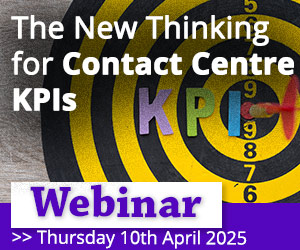Helen Billingham at Enghouse Interactive looks into customer frustration and how when customers contact your organisation, they want their enquiry resolved quickly.
Valuing their time and treating them with empathy is central to this. That’s why customers become irritated when asked to repeat information they have already provided after switching channels or when transferred to another agent.
In fact, in a recent Enghouse survey, 53% of consumers listed having to repeat the same information multiple times as a top three customer service frustration.
Customers want a personalised, joined-up approach that doesn’t involve repeating information numerous times. Not only is this tiresome for them, but it is inefficient for businesses. Agents should be able to focus on the problem they are aiming to solve. They shouldn’t have to recapture information provided elsewhere.
In today’s omnichannel world, enquiries are also becoming more complex. This means customer interactions are more likely to involve multiple touchpoints or multiple agents. So, the problem of customers having to potentially repeat themselves is growing. How can you minimise it?
1. Connect With the Right People, First Time
One solution is to try to avoid the need to transfer customers at all. Instead, ensure you connect them to the best available agent, first time. For instance, you can use IVR to screen incoming calls to understand the nature of the enquiry.
Then use this information to route it to the best available agent. In the same way, you could use a chatbot or multiple-choice questions to diagnose online enquiries. If the query is then escalated to an agent, they are fully briefed and have the right expertise to resolve the customer’s issue.
On digital channels such as email or social media, AI tools can analyse the text within incoming interactions and, based on content, tone, and sentiment, automatically route messages to the most appropriate available agent.
2. Integrate Your Contact Centre Systems
Often customers need to repeat themselves because agents don’t have access to information that was previously supplied or to up-to-date customer records. Typically, this is because of information silos between the contact centre and other systems (such as the CRM), or between different channels.
In fact, according to ContactBabel’s ‘The Inner Circle Guide to Agent Engagement & Empowerment’ report, 96% of contact centres agents have to use more than one system when interacting with customers.
This shows the need to integrate all the different applications that agents use into a single unified desktop. In turn this helps to break down any barriers to getting access to the right information, first time.
Similarly, it is essential to ensure that after each interaction, customer records are automatically updated and made available to agents.
Not only does this improve customer satisfaction, but it also improves the employee experience by removing repetitive administrative tasks. This will lead to increased efficiency and improve productivity.
3. Improve Your Agents’ Empathy and Listening Skills
Agents often take manual notes about customer calls before passing them onto their colleagues. And if they don’t note down everything accurately or comprehensively during the initial interaction, the customer will find themselves repeating the information.
So, it’s essential you train agents to listen carefully and extract all the right information. Tips include:
- Acknowledging the customer and allowing them time and space to talk
- Repeating what they have said back to them to ensure it has been correctly understood
- Asking the right follow-up questions
Agents should clearly be trained to apologise and show empathy if they have to ask for more details, demonstrating that they understand the customer’s frustrations.
4. Deliver Company-Wide Collaboration With Microsoft Teams
Often answering complex or specialist queries can involve many people within the business. These include front-line contact centre agents and back-office subject experts. Using a unified communication platform such as Microsoft Teams to underpin this collaboration can be really beneficial.
For example, Teams allows the seamless transfer of calls and sharing of ongoing interaction histories, avoiding the need for customers to go over the same information again.
Alternatively, the right platform can even avoid the need to transfer calls at all. Agents can easily bring subject experts into the conversation through real-time chat while the customer is still on the line.
Forcing customers to repeat themselves doesn’t just frustrate them, but it adds to your workload and lowers efficiency. Contact centres therefore need to measure and reduce repetition to increase customer satisfaction, loyalty and retention while boosting agent morale and efficiency.
This blog post has been re-published by kind permission of Enghouse Interactive – View the Original Article
For more information about Enghouse Interactive - visit the Enghouse Interactive Website
Call Centre Helper is not responsible for the content of these guest blog posts. The opinions expressed in this article are those of the author, and do not necessarily reflect those of Call Centre Helper.
Author: Enghouse Interactive
Published On: 5th Apr 2022
Read more about - Guest Blogs, Enghouse Interactive






 Enghouse Interactive delivers technology and expertise to help bring your customers closer to your business through its wide range of customer contact solutions.
Enghouse Interactive delivers technology and expertise to help bring your customers closer to your business through its wide range of customer contact solutions. 




























